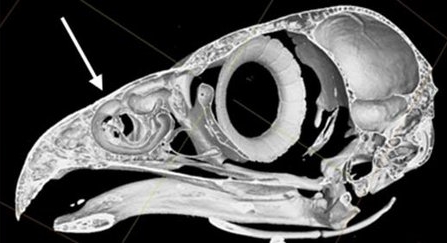
BIRDS OF PREY NEWS
Newsflash | August 3rd, 2022
NOSE DIVE: FALCONS
Of all the powers of the animal world that humans have envied and engineered into submission, nothing has become a more overdone trope of this desire than the flight of birds. In our endeavor to understand flight, we have broken down the components of aerodynamics into something we can quantify, calculate, and model. This approach has obviously worked quite well for us.
Just think about how a Boeing 747 jumbo jet can haul passengers from the East to West Coast of America in about six hours. The same journey would have taken wagon-driving pioneers months of life-threatening travel through forests, endless plains, deserts, snowy mountains, more deserts, and more mountains.
With our highly engineered view of flight, we tend to look back at living organisms and try to find elements of evolutionary design that seem perfectly adapted to certain modes of life. For example, let’s take a look at the nostrils of the
Peregrine Falcon (Falco peregrinus).
The
Peregrine Falcon is a
medium sized raptor, famous for its incredible high-speed dives. These dives, or stoops, are generally reported to clock in at
350 km/h (217 mph). This makes the Peregrine one of the fastest animals on Earth, “a feathered bullet dropping out of the sky”.
Such speeds requires many modifications, including some less obvious ones like redirecting airflow into the nostrils for breathing.

The force of air entering the nose at
350 km/h would cause the lungs to explode. In order to prevent this from happening, there are bony tubercles in the nares that act as baffles to safely regulate the passage of air into the respiratory system.
The nostrils of Peregrine Falcons inspired the design of inlet cones for supersonic jet engines.

That’s a cool fact, but what does it really mean?
To begin with, traveling at high speeds will not cause lungs to explode. Quite the opposite. There are two physical principles to keep in mind here:
(1) the Bernoulli Effect where higher air speed results in lowered air pressure and
(2) the energetically favored direction is always from high to low.
As the
Peregrine Falcon reaches top speed during the stoop, the increasing air speed encountered by the nares will result in a drop in air pressure. Inhalation relies upon relatively high pressure air outside the body rushing into the low pressure area of the lungs. Eventually, the air pressure outside the stooping falcon will approach equilibrium with the air pressure inside the lungs, making breathing very difficult.
Think about how it is harder to breathe when facing into a strong wind, sticking your head out a car window on a freeway (not necessarily recommended), or riding a fast boat. The presence of bony tubercles in the falcon’s nose act to slow down the airflow, increasing the air pressure, and allowing air to be drawn into the body. Seems like a clever bit of evolutionary adaptation to extreme high speed flight.
This tidy story is somewhat disrupted once we take a look at the phylogenetic distribution of narial bony tubercles. The Peregrine Falcon shares this morphological feature with all members of the Family Falconidae, which includes raptors of a wide variety of shapes, sizes, and flight abilities. At one end of the spectrum is the Peregrine Falcon that knocks its bird prey out of the air. At the other are the caracaras, which soar at a leisurely pace searching for carrion, much like vultures. This leaves us with a puzzle: if the tubercles within the nostrils of the Peregrine Falcon are adaptive for respiration at extreme flight speeds, why do all members of the Falconidae possess these tubercles?
It is possible that narial tubercles were present in the common ancestor of all Falconidae and, therefore, all its descendants still carry this feature. Perhaps the tubercles evolved to serve a different function — such as sensing airspeed or temperature — and this existing structure was modified with a new purpose in the Peregrines.
The conclusion is that we do not fully understand why the bony tubercles of the nostril appear in the Falconidae and what adaptive purpose (if any) it may serve.
(source: Hagler, Gina. Modeling Ships and Space Craft: The Science and Art of Mastering the Oceans and Sky)
© National Geographic - High-Velocity Falcon
